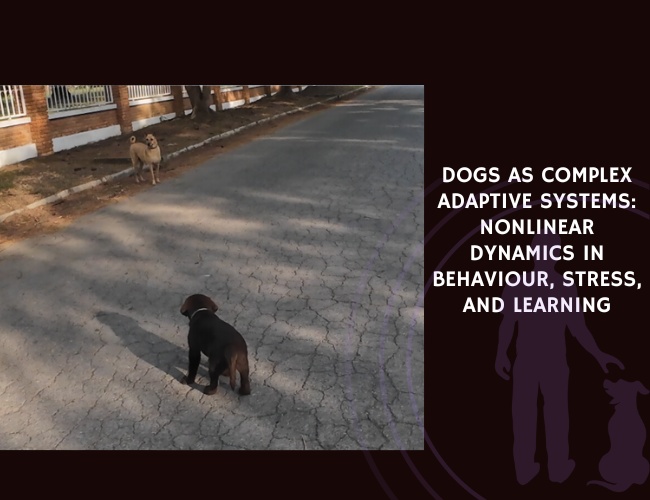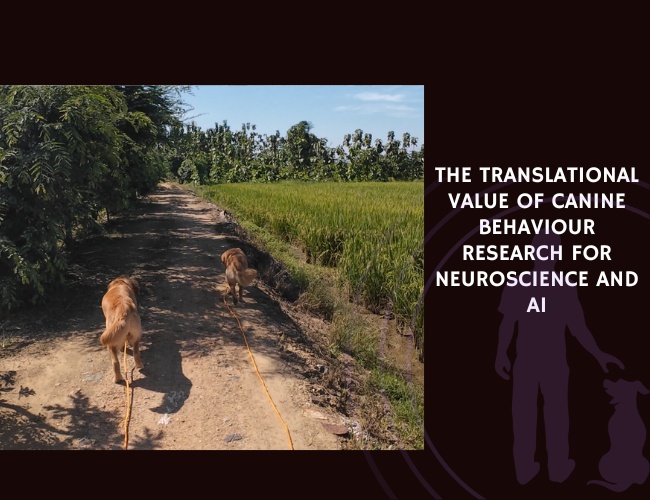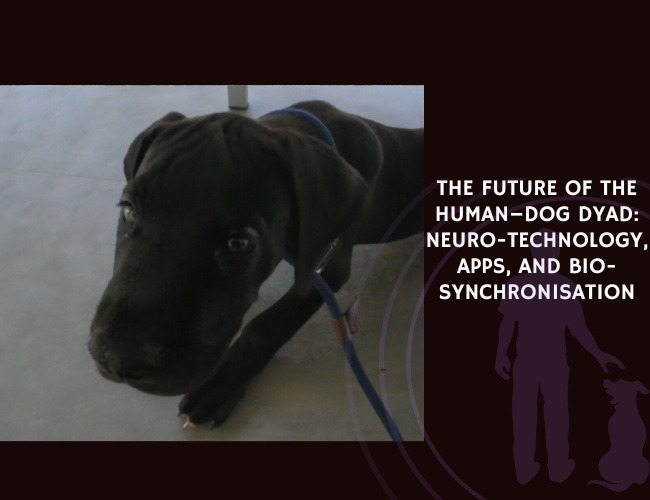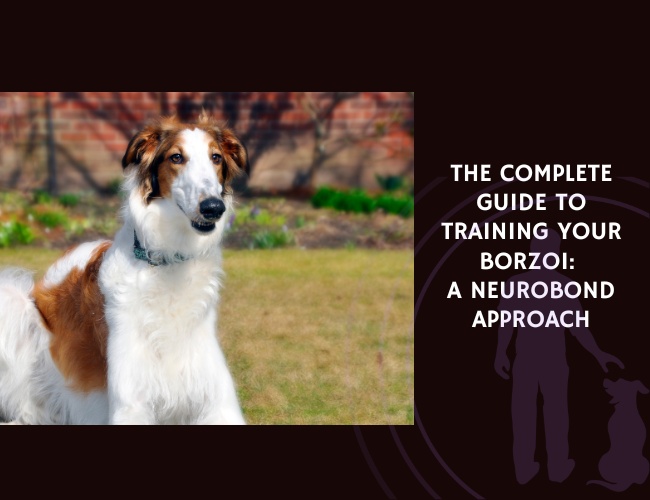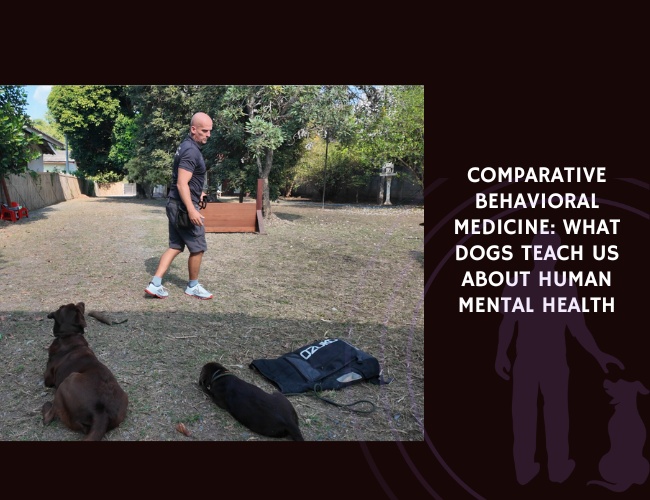Have you ever wondered why your furry friend seems to repeat certain behaviors, even when you’ve tried to discourage them? Or perhaps you’ve noticed how your own stress seems to make your dog more anxious? Welcome to the fascinating world of behavioral feedback loops – the invisible cycles that shape every interaction between you and your canine companion. Let us guide you through this journey of understanding how small actions create lasting patterns, and more importantly, how you can harness this knowledge to build a stronger, healthier relationship with your dog.
What Are Behavioral Feedback Loops in Dogs?
Understanding the Invisible Cycles That Shape Behavior
Imagine dropping a pebble into still water – the ripples spread outward, bounce off the edges, and create new patterns. This is exactly how feedback loops work in your dog’s behavior. Every action your dog takes leads to a consequence, and that consequence determines whether they’ll repeat that action again. It’s a continuous dance between behavior and outcome that shapes your dog’s entire worldview.
Positive feedback loops amplify behaviors, making them stronger and more frequent. Picture this: your dog barks at the delivery truck, the truck drives away (as it normally would), and your dog thinks, “Success! My barking worked!” Tomorrow, they’ll bark with even more enthusiasm. This loop strengthens the behavior each time it cycles through.
Negative feedback loops work to stabilize or reduce behaviors, bringing them back to balance. When your dog pulls on the leash and you stop walking, waiting until the leash relaxes before moving forward, you’re creating a negative feedback loop. Your dog learns that pulling actually prevents forward movement – the opposite of what they want. This understanding helps moderate their behavior over time.
The Power of Small Moments
You might be surprised to learn that the tiniest interactions can snowball into significant behavioral patterns. That quick glance you give your dog when they whine? It could be the seed of a demanding behavior that grows stronger each day. When your dog gently nudges your hand and you absentmindedly pet them while watching TV, you’ve just initiated a feedback loop. Over weeks and months, that gentle nudge might evolve into pawing, jumping, or persistent barking for attention.
These seemingly insignificant moments are actually powerful teaching opportunities. Your dog’s brain is constantly processing: “What worked? What didn’t? What should I try again?” Every interaction, no matter how brief, contributes to this ongoing calculation. Understanding this helps us appreciate why consistency in our responses is so crucial for our dogs’ emotional wellbeing and behavioral development.
Reinforcement and Behavioral Cycles
The Gambling Effect: Why Intermittent Rewards Create Persistent Behaviors
Here’s something that might surprise you: rewarding your dog occasionally for a behavior can actually make that behavior stronger than rewarding them every single time. This phenomenon, called intermittent reinforcement, works just like a slot machine – the unpredictability of the reward creates an almost addictive quality to the behavior.
Let’s explore demand barking as a perfect example. Your dog barks for attention, and most of the time you ignore it. But occasionally – maybe when you’re on an important call or just feeling worn down – you give in. Even if you only respond to the barking 10% of the time, your dog learns that persistence pays off. They don’t know when the jackpot will hit, so they keep pulling that behavioral lever, often with increasing intensity.
The extinction burst phenomenon reveals another fascinating aspect of these cycles. When you decide to stop reinforcing a behavior completely, your dog doesn’t simply give up. Instead, they often try harder than ever before – barking louder, longer, or trying new variations. This temporary escalation is their last-ditch effort to make the old strategy work. If you give in during this extinction burst (and many of us do because it’s so intense), you’ve just taught your dog that extreme persistence is the key to success.
When Love Reinforces the Wrong Things
Sometimes our best intentions create the very problems we’re trying to solve. This happens more often than you might think, especially when we’re trying to comfort our anxious or reactive dogs. Picture this scenario: your small dog growls at a larger dog approaching, and you immediately scoop them up, speaking in soothing tones. While you meant to protect and comfort, your dog may interpret this as praise for growling. “Good job warning me about that threat!” they might think, and the reactive behavior becomes stronger.
Similarly, when we pet a trembling dog during fireworks, intending to calm them, we might inadvertently communicate that their fear response is appropriate and worthy of attention. The feedback loop strengthens: fear leads to comfort, which validates the fear, which leads to more intense fear responses in the future. Understanding these dynamics doesn’t mean we should ignore our dogs’ distress – rather, we need to be strategic about how and when we provide comfort.
Stress as a Feedback Amplifier
The Cortisol Cascade: When Stress Feeds on Itself
Your dog’s stress response system, orchestrated by the Hypothalamic-Pituitary-Adrenal (HPA) axis, was designed for short-term threats – a quick burst of cortisol helps them respond to danger, then levels return to normal. But in our modern world, many dogs experience chronic stress that fundamentally rewires this system. Each stressful event triggers cortisol release, but when stress is constant, baseline cortisol levels remain elevated. This creates a devastating feedback loop where your dog becomes increasingly reactive to smaller and smaller triggers.
Think of it like this: imagine your stress threshold as a cup. A well-regulated dog has an empty cup that can handle quite a bit before overflowing. But a chronically stressed dog starts each day with a cup that’s already three-quarters full. The smallest additional stress – a doorbell, a strange dog, even a change in routine – causes an overflow. Each overflow (reactive episode) pumps more stress hormones into the system, keeping that baseline cup fuller and fuller. Soon, your once-confident dog is jumping at shadows, and you’re wondering what went wrong.
Living in a chronically stressful environment – perhaps with constant construction noise, unpredictable schedules, or tension between family members – can lock your dog into this escalating cycle. Their amygdala becomes hypersensitive, constantly scanning for threats. This hypervigilance itself becomes exhausting and stressful, feeding back into the cycle. Breaking free requires not just addressing individual triggers but lowering the overall stress load in your dog’s life.
The Emotional Mirror: Stress Contagion Between You and Your Dog
Here’s a remarkable truth that science has confirmed: you and your dog share an emotional feedback loop that operates at a physiological level. When you’re stressed, your body releases specific hormones and chemical signals that your dog can detect – not just through your behavior, but through subtle changes in your scent. Research has shown that dogs’ cortisol levels often synchronize with their owners’, creating a shared stress experience.
This synchronization creates a particularly challenging feedback loop. You come home stressed from work, your dog picks up on this and becomes anxious, their anxious behavior (maybe pacing or whining) increases your stress because now you’re worried about them too, which makes them more anxious… and round and round it goes. This biological dance happens largely below our conscious awareness, but its effects on both species’ wellbeing are profound.
Understanding this connection offers both a warning and an opportunity. The warning: your emotional state directly impacts your dog’s behavioral stability. The opportunity: by managing your own stress and emotional regulation, you’re not just helping yourself – you’re actively contributing to your dog’s emotional wellbeing. This is why many behavioral interventions now focus as much on coaching the human as training the dog.
Threshold Models: The Tipping Point Between Calm and Chaos
Every dog has behavioral thresholds – invisible lines that, when crossed, shift them from one emotional state to another. Think of these as tipping points: below the threshold, your dog might be alert but manageable; cross it, and they flip into full reactive mode. Stress dramatically lowers these thresholds, making your dog more likely to tip into problematic behaviors.
A relaxed dog might need significant provocation to react aggressively – perhaps direct threatening behavior from another dog. But a stressed dog with depleted emotional resources might react to simply seeing another dog at a distance. Each reactive episode that “works” (the scary thing goes away) reinforces the behavior, while simultaneously keeping stress levels high, which keeps thresholds low. It’s a self-perpetuating cycle that pushes your dog deeper into maladaptive patterns.

Human Communication and Feedback Loops
Your Body Speaks Louder Than Words
Dogs are masters at reading human body language – they’ve evolved alongside us for thousands of years to become experts at interpreting our smallest movements and postures. This incredible sensitivity means that your physical presence alone can trigger or prevent behavioral feedback loops. Your tense shoulders when you see another dog approaching tells your dog “danger ahead” before you’ve said a word. This anticipatory tension creates a feedback loop where your dog becomes reactive because they’ve learned to trust your body’s warning signals.
Timing is everything in these communication feedback loops. The difference between reinforcing jumping versus reinforcing calm greetings might be just two seconds – praising while paws are still airborne versus waiting for all four paws on the ground. These micro-moments of timing create vastly different behavioral trajectories. Poor timing doesn’t just fail to teach the right behavior; it actively reinforces the wrong one, creating strong positive feedback loops that become increasingly difficult to change.
Your tone of voice adds another layer to these cycles. A sharp, scolding tone might seem like it’s correcting behavior, but for many dogs, it simply adds stress to an already tense situation. This increased stress lowers their ability to learn and raises their reactivity, creating a feedback loop where corrections lead to more problematic behavior, which leads to more corrections. Conversely, a calm, steady voice can act as an anchor, helping your dog regulate their emotional state and breaking the cycle of escalation.
The Anthropomorphism Trap: When We Misread Our Dogs
We naturally interpret our dogs’ behavior through a human lens – it’s how our brains make sense of the world. But this anthropomorphic tendency can create particularly destructive feedback loops. When your dog destroys your favorite shoes, you might think they’re being spiteful about being left alone. This interpretation leads you to punish the “spite,” which increases your dog’s anxiety about your departures, which leads to more destructive behavior as a coping mechanism, which confirms your belief about spite… and the cycle continues.
Similarly, when we interpret a dog’s warning growl as “being mean” rather than recognizing it as communication, we might punish the growl. The dog learns that warning signals don’t work and might skip straight to biting next time. Or they might suppress all warning signals while their discomfort grows, creating a feedback loop of increasing tension with no outlet – until it explodes in a seemingly “random” attack. Understanding canine communication on its own terms, rather than through human interpretation, is crucial for breaking these cycles.
Attachment Styles: The Foundation of All Feedback Loops
The quality of attachment between you and your dog sets the stage for all other behavioral feedback loops. Secure attachment creates resilient, adaptive cycles. When your dog trusts that you’re consistently available and responsive, they develop confidence to explore the world. They check in with you when uncertain, you provide calm reassurance, they return to exploration. This creates a beautiful negative feedback loop that maintains emotional balance.
Insecure attachment, often stemming from inconsistent responses, generates anxious feedback loops. If sometimes you respond to your dog’s bids for attention and sometimes you don’t, with no clear pattern your dog can understand, they become anxious about the relationship itself. This anxiety drives increasingly intense attention-seeking behaviors – constant nudging, whining, following you everywhere. These behaviors might sometimes get reinforced and sometimes ignored, deepening the anxiety and intensifying the bids for connection. The unpredictability itself becomes a source of chronic stress.
The power of attachment extends beyond individual behaviors to influence your dog’s entire worldview. A securely attached dog sees the world as basically safe with you as their secure base. An insecurely attached dog sees the world as unpredictable and potentially threatening, with you as an unreliable source of safety. These fundamental orientations create cascading feedback loops that influence every aspect of behavior, from how they greet strangers to how they handle being alone.
Cyclic. Subtle. Powerful.
Loops shape behaviour. Every action creates consequences that ripple back, teaching dogs what to repeat and weaving invisible cycles into daily life.
Small moments matter. A glance, a touch, or a sigh can reinforce patterns over time, turning fleeting interactions into lasting habits and expectations.
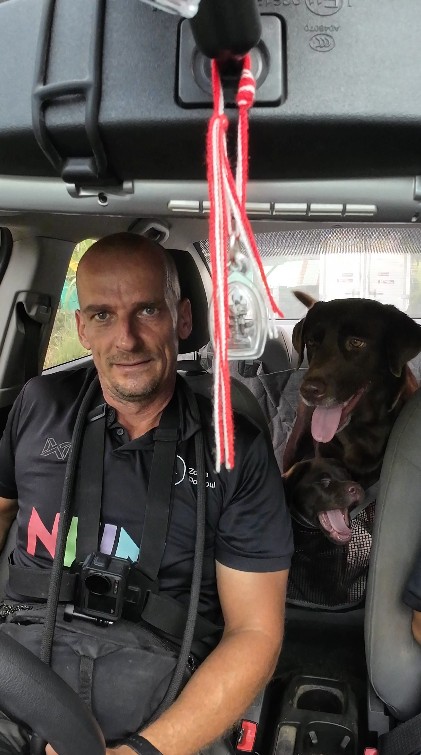


Intermittence fuels persistence. Occasional rewards act like jackpots, strengthening behaviours through unpredictability and making them harder to extinguish.
Breaking Maladaptive Loops
Rewiring the Brain: Counterconditioning and Desensitization
Breaking established feedback loops requires patience and systematic intervention. Desensitization works by presenting triggers at such low intensity that they don’t activate the problematic feedback loop. Imagine your dog reacts to other dogs at 20 feet. You start at 100 feet – far enough that your dog notices but doesn’t react. At this distance, the trigger doesn’t cross their threshold, so the reactive feedback loop never engages. Gradually, over weeks or months, you decrease the distance, allowing your dog’s nervous system to recalibrate its threat assessment.
Counterconditioning goes a step further by creating an entirely new feedback loop to compete with the old one. While your dog is calm at that safe distance, you pair the sight of another dog with something wonderful – their favorite treats, a fun game, loving praise. You’re literally rewiring their brain to create a new association: other dogs predict good things. This new positive feedback loop gradually overwrites the old reactive one. The key is working below threshold – if your dog is already reacting, they can’t learn the new association.
The beauty of combining these techniques is that they attack maladaptive loops from multiple angles. Desensitization prevents the old loop from activating, while counterconditioning builds a new, incompatible loop. Together, they create a powerful intervention that can transform even deeply entrenched behavioral patterns. Success requires consistency, patience, and careful attention to your dog’s emotional state throughout the process.
Creating an Environment for Success: Stress Reduction Protocols
Remember that stress amplifies all maladaptive feedback loops, so reducing overall stress load is crucial for behavioral change. Predictability is your first tool. Dogs thrive on routine because it reduces uncertainty – a major stress trigger. When your dog knows that breakfast comes at 7 AM, walks happen at 8 AM and 5 PM, and bedtime is at 10 PM, their stress system can relax. This predictability creates a negative feedback loop that maintains calmness.
Enrichment addresses another core need. A bored dog is a stressed dog, and stress feeds behavioral problems. Puzzle feeders, scent work, appropriate chew toys – these aren’t just entertainment. They allow your dog to engage in natural behaviors that release tension and promote satisfaction. Each successful problem-solving experience builds confidence, creating positive feedback loops that support emotional resilience. The mental fatigue from enrichment also naturally raises behavioral thresholds, making reactive episodes less likely.
Exercise plays a complex role in feedback loops. Appropriate physical activity helps metabolize stress hormones and promotes the release of calming neurotransmitters. But here’s the catch: over-exercising an already stressed dog can actually worsen the problem, creating a feedback loop where they need increasingly intense exercise to feel calm. The goal is finding the sweet spot where exercise reduces stress without becoming another source of pressure or arousal.
Training the Human: The Most Important Intervention
Often, the most powerful way to break your dog’s maladaptive loops is to change your own behavior. This isn’t about blame – it’s about recognizing that you’re the one with the cognitive capacity to understand these patterns and consciously change them. Learning to identify triggers is your first step. What specific situations or cues initiate the unwanted behavior? Once you can predict it, you can prevent it or prepare to respond differently.
Modifying your own responses requires conscious effort and often feels unnatural at first. If you’ve been inadvertently reinforcing demand barking by occasionally giving in, you’ll need to commit to never reinforcing it again – even when it’s inconvenient. This means having a plan for those moments when ignoring the barking is hardest. Maybe you step outside, put in earbuds, or give yourself a specific task to focus on. Breaking your part of the feedback loop is essential for changing your dog’s behavior.
Understanding dog communication accurately prevents misinterpretation that feeds problematic loops. Learning to recognize the difference between a play bow and a stress signal, between confident tail wagging and anxious tail wagging, between a relaxed pant and a stress pant – these distinctions matter enormously. When you respond appropriately to what your dog is actually communicating rather than what you think they’re saying, you create clear, consistent feedback that helps your dog develop adaptive behaviors.
Applications for Training and Welfare
Building Resilience: Designing Adaptive Feedback Loops
Rather than just breaking negative loops, we can intentionally create positive ones that promote resilience and emotional stability. Teaching a “settle” or “relax” cue creates a powerful tool for emotional regulation. Every time your dog successfully calms themselves on cue and receives reinforcement, you strengthen neural pathways associated with calmness. Over time, this creates a feedback loop where your dog becomes increasingly skilled at self-soothing.
Confidence-building exercises establish loops that promote brave, curious behavior. Starting with tiny challenges – perhaps walking over a towel on the ground – and celebrating success creates a positive association with novel experiences. Each success makes your dog slightly braver, more willing to try the next new thing. This creates an expanding spiral of confidence where your dog learns that new doesn’t mean dangerous, and investigation is rewarding.
The power of these designed loops extends beyond specific behaviors to influence your dog’s overall emotional resilience. A dog who has learned through repeated positive feedback loops that they can handle challenges develops what we might call “learned optimism.” They approach new situations with curiosity rather than fear, creating a self-reinforcing cycle of positive experiences and growing confidence.
Multi-Dog Dynamics: When Loops Interweave
In households with multiple dogs, feedback loops become exponentially more complex. One dog’s anxiety doesn’t exist in isolation – it ripples through the pack, potentially triggering or amplifying other dogs’ stress responses. You might notice that when one dog alert-barks, others join in, creating a cacophony that raises everyone’s arousal level. This group feedback loop can quickly spiral out of control, transforming a minor trigger into a household-wide frenzy.
Social learning adds another layer to these multi-dog feedback loops. Dogs watch and learn from each other constantly. If one dog’s reactive behavior successfully makes scary things go away (from their perspective), other dogs may adopt the same strategy. Conversely, a calm, confident dog can serve as a model, their steady presence creating a calming feedback loop that helps anxious pack mates regulate their emotions. Understanding these dynamics helps us strategically use social learning to our advantage.
Managing multi-dog feedback loops requires considering the group as a system, not just individual dogs. Sometimes, the best intervention for one dog’s anxiety is actually addressing another dog’s behavior that triggers it. Creating separate spaces for decompression, ensuring each dog has individual attention and training time, and managing group dynamics during high-stress periods (like doorbell rings) all help prevent negative feedback loops from cascading through the pack.
Shelter Applications: Breaking Institutional Feedback Loops
Animal shelters present a perfect storm for maladaptive feedback loops. The constant barking creates a feedback loop where each dog’s stress contributes to a cacophonous environment that stresses every dog, leading to more barking. The unpredictability of shelter life – different handlers, changing kennel neighbors, irregular schedules – keeps stress systems on constant alert. This chronic stress lowers behavioral thresholds, making dogs more reactive, which makes them less adoptable, which extends their stay, which increases their stress…
Breaking these institutional loops requires systematic intervention at multiple levels. Implementing quiet hours gives dogs’ nervous systems a chance to reset, interrupting the constant stress-barking cycle. Predictable routines, even simple ones like feeding times and cleaning schedules, create islands of certainty in an uncertain environment. Enrichment programs that allow dogs to engage in natural behaviors provide outlets for stress and frustration that don’t involve barking or other problematic behaviors.
Training shelter staff and volunteers to recognize and respond appropriately to stress signals prevents well-meaning interactions from reinforcing maladaptive behaviors. Teaching them to reward calm behavior, ignore attention-seeking behaviors, and provide comfort in ways that don’t reinforce anxiety creates consistent feedback that helps dogs maintain better emotional regulation despite the challenging environment. These interventions don’t just improve life in the shelter – they help dogs develop coping skills that serve them well in their adoptive homes. 🐾
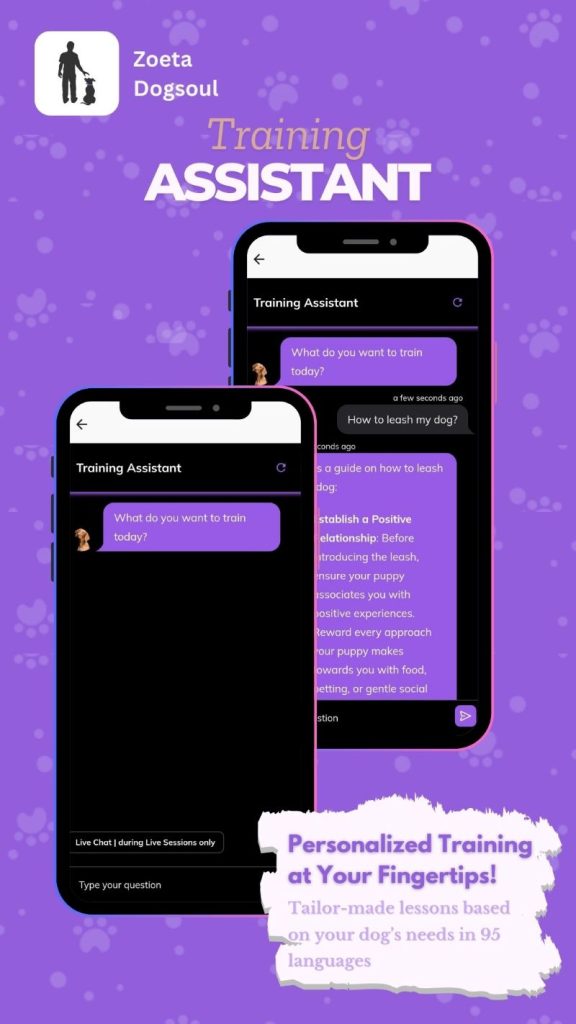
The Science Behind the Cycles
Understanding the Neurological Foundations
The feedback loops we’ve explored aren’t just behavioral phenomena – they’re rooted in the very structure and function of your dog’s brain. When a behavior is reinforced, specific neural pathways strengthen through a process called long-term potentiation. Imagine these pathways as trails through a forest: the more they’re used, the clearer and easier to follow they become. This is why established feedback loops can be so persistent – they’ve literally carved channels in your dog’s brain.
The amygdala, your dog’s alarm system, plays a crucial role in emotional feedback loops. In dogs with chronic stress or trauma, the amygdala becomes hyperactive, constantly scanning for threats and triggering stress responses at the slightest provocation. This creates a neurological feedback loop where the overactive amygdala keeps the dog in a state of hypervigilance, which provides more opportunities for the amygdala to fire, which strengthens its hypersensitivity. Understanding this helps us appreciate why simple “training” often isn’t enough – we need to address the underlying neurological state.
The Role of Neurotransmitters in Behavioral Cycles
Various neurotransmitters orchestrate these feedback loops at a chemical level. Dopamine, the reward chemical, surges when your dog successfully gets what they want, whether that’s attention from demand barking or the mailman “retreating” after being barked at. This dopamine hit reinforces the neural pathway, making the behavior more likely to occur again. Serotonin, associated with mood regulation and impulse control, can become depleted in chronic stress, making dogs more susceptible to reactive feedback loops.
Understanding these chemical underpinnings reveals why certain interventions work. Exercise promotes the release of endorphins and helps regulate neurotransmitter balance. Predictable routines support steady serotonin production. Positive reinforcement training leverages the dopamine system to build desired behaviors. We’re not just changing behaviors – we’re literally altering your dog’s brain chemistry in ways that support emotional wellbeing and behavioral stability.
Practical Implementation: Your Action Plan
Starting Your Feedback Loop Assessment
Begin by observing your dog’s behavior patterns over a week. Keep a simple log noting triggers, responses, and outcomes. You’re looking for patterns: Does your dog always bark when you’re on the phone? Do they pull more on the leash after seeing other dogs? These observations reveal existing feedback loops. Pay special attention to your own responses – are you inadvertently reinforcing behaviors you’d prefer to change?
Next, identify which loops serve your dog well and which create problems. Not all feedback loops need intervention. Your dog’s excitement when you pick up their leash, creating a positive association with walks? That’s a keeper. Their increasing anxiety when you prepare to leave? That needs attention. Prioritize addressing loops that impact your dog’s welfare or significantly affect your relationship.
Creating Your Intervention Strategy
Start with the simplest interventions that address multiple loops simultaneously. Implementing a consistent daily routine, for example, reduces overall stress while preventing anxiety-driven feedback loops from engaging. Choose one or two specific behavioral loops to address initially – trying to change everything at once creates confusion and inconsistency that can worsen existing problems.
For each problematic loop you’ve identified, develop a specific plan:
- Prevent the trigger when possible (management)
- Change your response to break your part of the cycle
- Create an incompatible alternative behavior to reinforce
- Address underlying stress that amplifies the loop
- Be consistent – inconsistency creates the most persistent behavioral problems
Remember that changing established feedback loops takes time. Neural pathways don’t rewire overnight. Expect progress to be gradual, with occasional setbacks. The extinction burst phenomenon means things might temporarily worsen before they improve. Having realistic expectations helps you maintain the consistency necessary for success.
Living in Harmony: The Long-Term View
Maintenance and Adjustment
Even after successfully modifying problematic feedback loops, maintenance is crucial. Old neural pathways don’t disappear completely – they become dormant. Under stress or with inconsistent reinforcement, old patterns can resurface. Think of it like maintaining a garden: ongoing attention prevents weeds from taking over again. Regular training sessions, consistent responses, and stress management keep positive feedback loops strong and negative ones dormant.
Life changes – new baby, moving house, family illness – can disrupt established patterns and trigger old feedback loops. Anticipating these challenges and having strategies ready helps prevent relapse. During transitions, increasing predictability in other areas of your dog’s life, providing extra enrichment, and being patient with temporary behavioral regression can help your dog navigate change without falling back into maladaptive patterns.
Building a Feedback-Aware Lifestyle
Understanding feedback loops transforms how you interact with your dog daily. You become aware of the teaching that happens in every moment, not just during formal training sessions. This awareness might feel overwhelming initially, but it quickly becomes second nature. You’ll find yourself naturally preventing problematic loops from forming and reinforcing positive ones without conscious effort.
This feedback-aware approach extends beyond problem-solving to enhance your entire relationship. You’ll notice and reinforce subtle moments of calmness, bravery, or friendliness that you might have previously overlooked. These micro-reinforcements create an environment rich in positive feedback loops that support your dog’s best qualities. Your dog becomes more confident, more settled, and more responsive – not through intensive training but through thoughtful daily interactions.
Conclusion: Embracing the Dance of Connection
Understanding feedback loops reveals a profound truth about our relationships with our dogs: every interaction matters, and small changes can create dramatic transformations. These invisible cycles shape not just individual behaviors but your dog’s entire experience of the world. By recognizing and intentionally crafting these loops, you’re not just training behaviors – you’re nurturing your dog’s emotional wellbeing and strengthening your mutual bond.
The journey of working with feedback loops requires patience, consistency, and compassion – for your dog and for yourself. Mistakes are inevitable, and perfection isn’t the goal. What matters is developing awareness of these patterns and gradually shifting them in positive directions. Each small success creates ripples that spread through your dog’s behavioral repertoire, building resilience, confidence, and joy.
As you move forward with this knowledge, remember that you and your dog are partners in creating these behavioral patterns. Your calm presence can break a stress cycle. Your consistent responses can transform demanding behaviors into polite requests. Your understanding of your dog’s true communication can prevent misunderstandings that fuel anxiety. In recognizing the power of feedback loops, you’ve gained not just training techniques but a deeper understanding of the profound connection you share with your canine companion. Together, you’re not just living with feedback loops – you’re dancing with them, creating a rhythm of interaction that enriches both your lives. 🧡
Next Steps for Your Journey
Ready to put this knowledge into practice? Start with observation – spend the next week simply noticing patterns without trying to change them. Then choose one feedback loop to address, creating a specific plan using the strategies we’ve explored. Remember, lasting change happens gradually, one loop at a time. Your dog’s behavior is a conversation, and now you understand the language. The beautiful journey of conscious connection awaits both of you.

